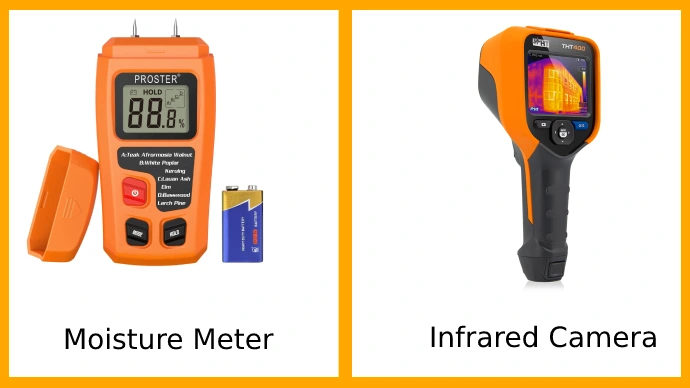Last Updated on March 13, 2023
Aspiring and seasoned woodworkers alike know identifying moisture-related issues is a must. Moisture meters and infrared cameras can be great allies in this endeavor, but what’s the difference?
Moisture meters and infrared cameras may sound similar, but they are quite different. Moisture meters measure the amount of water in a material, while thermal imaging cameras pick up on heat radiating from objects and turn it into digital signals for easier readouts.
This blog post reveals all, from fundamental principles to portability features and maintenance needs. Discover how each instrument offers its benefits (and limitations), so you can decide what’s appropriate for your project.
Moisture Meter Vs Infrared Camera Comparisons
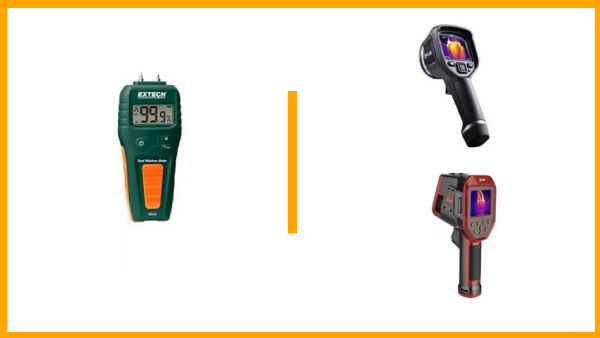
Moisture meters and infrared cameras are two tools that professionals can use to detect and diagnose moisture issues. While both tools have their benefits, they each have unique features that make them better suited for certain jobs. Here is a comparison of these two helpful tools:
01: Principles of Operation
A moisture meter is a device used to measure the moisture content in materials such as wood and drywall. It does this by using two electrodes to take a reading from the material being measured and comparing it to readings taken from other materials known for their constant moisture levels.
Moisture meters can be used in various industries, such as woodworking and construction, to identify moisture-related problems. In woodworking, moisture meters are often used to test boards for their suitability for use in projects or to determine when the lumber has reached its optimal drying level.
Unlike a moisture meter, an infrared camera detects thermal energy or heat emitted by the scene being observed, which is then processed into an image. This image can then be used to identify problems that aren’t visible to the naked eye due to thermal differences in the observed surface.
An infrared camera is also used in many industries, including woodworking, for inspection and analysis purposes. An infrared camera can help you find water and moisture in a piece of wood before you start working with it. The camera picks up on temperature changes, showing you where the water is.
02: Uses Sectors
Moisture meters are primarily used in industries such as construction and carpentry, where they are necessary for testing materials such as walls, floors, and timber for excess moisture content before work begins on them.
They are particularly useful when installing new flooring or working on areas prone to dampness or humidity due to their ability to detect any excess moisture present within the tested material quickly.
Open houses can also be used during drywall installation projects to ensure everything stays dry. This will prevent any future issues with mold growth caused by moisture that gets trapped between sheets of drywall.

Infrared cameras have a much broader range of uses beyond just woodworking. Thermal cameras are often used in fields such as electrical engineering, HVAC system maintenance, and building inspection. This is because they can quickly identify areas that may need further investigation without requiring physical contact with whatever surface is being inspected.
Regarding carpentry specifically, infrared cameras allow inspectors and craftsmen alike to see behind surfaces that would otherwise be inaccessible. With complex carvings, you have to cut through sections you can’t see without special equipment, like an IR camera, so you can see what’s underneath whatever surface you’re working on before you start.
03: Accuracy & Reliability
The accuracy of both devices largely depends on how well-calibrated they are. If they are not calibrated correctly, it could cause the instruments to give faulty readings. This could lead to severe issues if not appropriately addressed.
Especially when dealing with things like flooring or wall installations. If left unchecked, dampness could cause structural damage over time due to rot setting in.
Generally, moisture meters and infrared cameras are accurate when set up correctly. Most moisture meters have digital sensors which take precise measurements within seconds. Infrared cameras have sensitive thermometers that detect tiny temperature changes across different surfaces. This makes them both useful for finding and solving complex problems.
04: Ease of Use & Portability
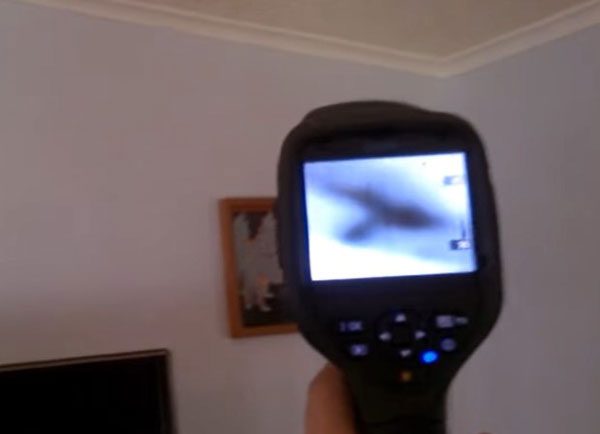
Moisture meters require minimal setup and training and can be used with one hand, allowing users to take readings in various locations quickly. They are also lightweight, making them easy to move around the workspace.
On the other hand, infrared cameras require more setup and are heavier due to the battery pack attached. This makes them less portable than moisture meters. They allow for quick diagnosis of problems that might not be visible or detectable without the camera’s thermal imaging capabilities.
05: Maintenance Requirements
Moisture meters typically don’t need regular maintenance since they’re relatively simple devices with few moving parts. But, it is crucial to protect them from water damage as this can affect their accuracy over time.

Infrared cameras require frequent maintenance since they have multiple components and delicate optics that must be kept clean to ensure accuracy in readings. And calibration should be done regularly on IR cameras as heat sources within the scanning area may change over time which can lead to inaccurate readings if not correctly calibrated.
06: Benefits and Limitations
Both moisture meters and infrared cameras offer unique benefits when it comes to woodworking. Moisture meters allow for easy moisture content measurements in board stock, which helps confirm whether it is suitable for use in a project before beginning work on it.
Infrared cameras provide quick diagnosis of issues such as delamination or areas with excessive heat loss due to poor insulation or air leaks.
But both come with limitations. Moisture meters cannot measure behind surfaces, while infrared cameras are pricier than conventional moisture testers due to their advanced capabilities. Also, they require skilled personnel who understand how this technology works to utilize its full potential properly.
Why Do Infrared Cameras Indicate Possible Moisture in Materials?
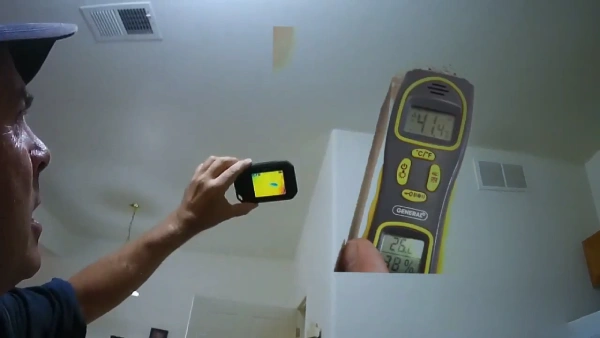
Infrared (IR) cameras are used to detect the presence of moisture in materials by picking up subtle temperature differences that can indicate the presence of water.
The camera can differentiate between wet spots in building materials, such as walls, and the surrounding environment. This allows professionals to identify potential problems before they become more costly issues quickly. Here are some examples of infrared (IR) cameras:
Higher Resolution 320 x 240 IR Infrared Camera
This highly advanced infrared camera boasts a resolution of 320 x 240, allowing users to capture clear, precise images with stunning clarity.
The camera has multiple functions, such as real-time thermal imaging and object tracking capabilities, a wide range of image adjustment options, and an intuitive user interface. It is also dust-proof and water-resistant, making it suitable for use indoors or outdoors in any weather conditions.
IR Resolution Thermal Imaging Camera
This precision thermal imaging camera offers superior image quality in the daytime and nighttime settings. It features an impressive resolution of up to 640×480 and sensitive thermopile technology that can detect temperature differences as low as 0.06°C at a distance of up to 1000m.
The camera is designed with a 3D digital zoom function that allows users to focus on specific objects or areas within the field of view without sacrificing image quality.
Handheld Dual Camera Infrared Thermal Imager
This handheld dual-camera infrared imager provides optimal performance in a robust yet compact design that is perfect for professionals on the go or those requiring high levels of accuracy in their work environment.
It combines two cameras, one infrared and one visible. It delivers advanced imaging capabilities such as single-shot multispectral imaging, multi-exposure blending, and quick response times so you can capture every detail with unmatched precision.
Can a Moisture Meter Detect Mold?
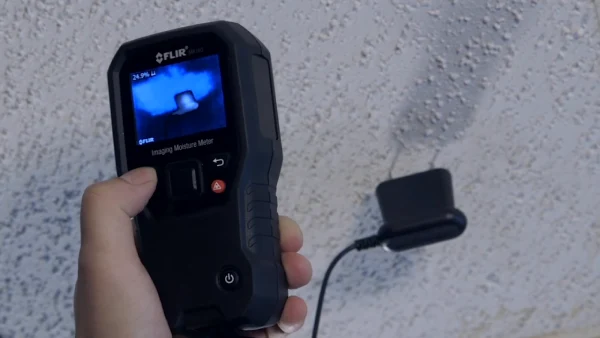
Many professionals use moisture meters to identify damp areas where mold may grow. These devices measure moisture content in different building materials, such as wood, brick, and drywall, helping to pinpoint areas with high humidity levels that could be conducive to mold growth.
Also, they can estimate how much moisture is present in the material, which can aid in determining if the surface will require further investigation or treatment. Here are some examples of moisture meters:
Digital Moisture Meter & Water Leak Detector
Keep your home safe from potential water damage with this digital moisture meter and water leak detector combo device. It accurately detects moisture levels within walls, floors, and ceilings.
This device helps you find leaks by using three sensors simultaneously. It is faster than ever before. Plus, its waterproof housing ensures reliable performance even in wet conditions.
Moisture Meter for Non-Destructive Moisture Detection
Get fast, accurate results without disturbing surfaces using this non-destructive moisture meter that features advanced technologies such as capacitance technology for accurate measurements even through paint layers or wall coverings like wallpaper or tiles.
Its flexible detection probes allow for access to tight spaces, making it ideal for identifying hard-to-reach moisture levels, while its interactive LCD helps you easily understand the readings quickly so you can act accordingly.
Moisture Meter and Thermal Imager with MSX
Get peace of mind knowing exactly where moisture exists in your home or business with this advanced combination moisture meter and thermal imager featuring patented MSX technology.
Not only does it detect humidity levels accurately down to 0%RH, but it also gives you detailed thermal images that highlight problem hot spots, which can often be invisible to the naked eye. It gives you all the information needed to make informed decisions quickly.
Is the Thermal Camera the Same As the IR camera?
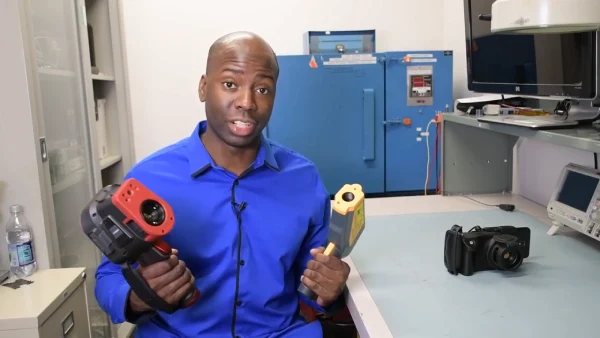
A thermal camera and an infrared (IR) camera are not the same. A thermal camera uses heat emitted from objects to create an image, while an IR camera captures near-infrared light that is reflected off of objects.
Thermal cameras can detect extremely subtle temperature differences and can be used to identify areas of moisture or mold in a building, while IR cameras can give more detailed information regarding the source of the moisture.
Is an Infrared Camera Better Than a Moisture Meter?
Infrared cameras are generally better than moisture meters for detecting moisture in materials because they can provide a more comprehensive image of the surface being scanned.
An IR camera gives detailed images that show patterns of possible water intrusion and indicate subtle temperature variations that may be caused by dampness in materials.
On the other hand, a moisture meter only takes readings from one point at a time. It does not provide images with as much information about possible sources of water infiltration.
Moisture Meters vs Thermal Imaging Cameras: Which Is Right For You?
Overall, moisture meters and infrared cameras are two valuable tools for woodworking. While they serve different purposes and have different uses across various sectors, both can be used to detect potential problems and damage from moisture buildup in structures.
It’s essential to evaluate each tool’s operation principles, accuracy, reliability, ease of use & portability, maintenance requirements, and benefits & limitations before choosing which one to use for a particular job.
With careful consideration of all these factors discussed above, plus knowledge of how each tool works, woodworkers can make the proper selection for the task at hand.
